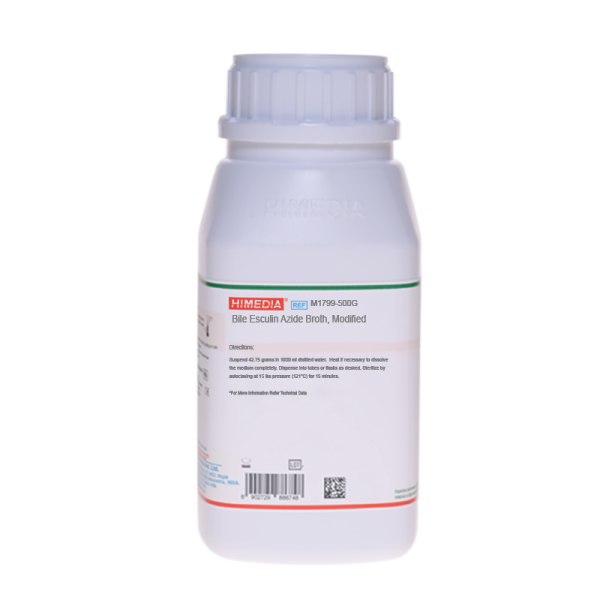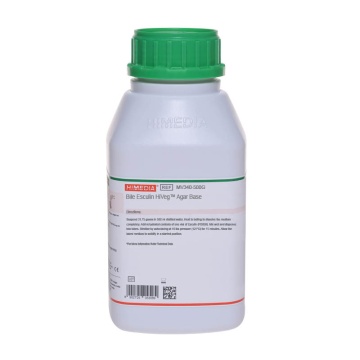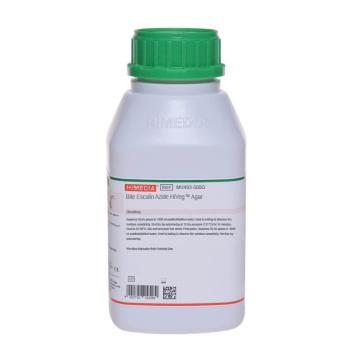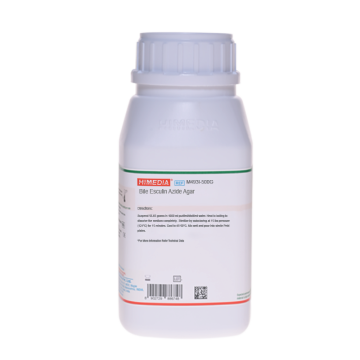 Your enquiry has been submitted
Your enquiry has been submitted
Bile Esculin Azide Broth, Modified
Bile Esculin Azide Broth, Modified is used to differentiate between Enterococci and Group D Streptococci.
Composition**
| Ingredients | Gms / Litre |
|---|---|
| Casein enzymic hydrolysate | 17.000 |
| Peptic digest of animal tissue | 3.000 |
| Yeast extract | 5.000 |
| Oxgall | 10.000 |
| Sodium chloride | 5.000 |
| Esculin | 1.000 |
| Ferric ammonium citrate | 0.500 |
| Sodium azide | 0.250 |
| Sodium citrate | 1.000 |
Final pH (at 25°C): 7.1±0.2
**Formula adjusted, standardized to suit performance parameters
Directions
Suspend 42.75 grams in 1000 ml distilled water. Heat to boiling to dissolve the medium completely. Sterilize by autoclaving at 15 lbs pressure (121°C) for 15 minutes.
Caution: Sodium azide has a tendency to form explosive metal azides with plumbing materials. It is advisable to use enough water to flush off the disposables.
Principle And Interpretation
Bile Esculin Azide Broth, Modified is similar to the medium developed by Isenberg et. al. (1) but with agar omitted.
Casein enzymic hydrolysate, peptic digest of animal tissue and yeast extract serve as a source of carbon, nitrogen and essential nutrients. Sodium azide inhibits growth of gram-negative organisms and permits the cultivation of Enterococci and group D Streptococci. Oxgall inhibits gram-positive bacteria other than Enterococci. Sodium citrate acts as a buffering agent. Esculin is hydrolysed by Enterococci and group D streptococci to esculetin which reacts with ferric ammonium citrate to form dark brown or black complex (2). Colonies suspected of being Enterococci can be emulsified in 2ml of broth (Bile esculin azide broth, modified) and incubated at 35- 37ºC. The combination of esculin and bile in presence of sodium azide permits the selection and differentiation of Enterococci by esculin hydrolysis (Blackening of medium) within 2hours (1), when heavy inoculum is used.
Quality Control
Appearance: Cream to yellow homogeneous free flowing powder
Colour and Clarity of prepared medium: Amber coloured, clear to slightly opalescent solution with a bluish tinge.
Reaction: Reaction of 4.275% w/v aqueous solution at 25°C. pH : 7.1±0.2
pH: 6.90-7.30
Cultural Response: Cultural characteristics observed after an incubation at 35-37°C for 18-24 hours.
| Organism | Inoculum (CFU) | Growth | Esculin Hydrolysis |
|---|---|---|---|
| Enterococcus faecalis ATCC 29212 | 50-100 | luxuriant | positive reaction, blackening of medium |
| Escherichia coli ATCC 25922 | 50-100 | none-poor | negative reaction |
| Staphylococcus aureus ATCC 25923 | 50-100 | good | negative reaction |
| Streptococcus pyogenes ATCC 19615 | 50-100 | none-poor | negative reaction |
Storage and Shelf Life
Store below 30°C in tightly closed container and the prepared medium at 2 - 8°C. Use before expiry date on the label.
Reference
- Isenberg, Goldberg and Sampson, 1970, Appl. Microbiol. 20:433.
- MacFaddin, 2000. Biochemical test for identification of medical bacteria, 3rd ed. Lippincott William & Wilkins, Baltimore, Md.
| Product Name | Bile Esculin Azide Broth, Modified |
|---|---|
| SKU | M1799 |
| Product Type | Regular |
| Physical Form | Powder |
| Origin | Animal |
| Packaging type | HDPE |
| References | 1.Isenberg, Goldberg and Sampson, 1970, Appl. Microbiol. 20:433.2.MacFaddin, 2000. Biochemical test for identification of medical bacteria, 3rd ed. Lippincott William & Wilkins, Baltimore,Md. |
| Customized Product Available | No |












